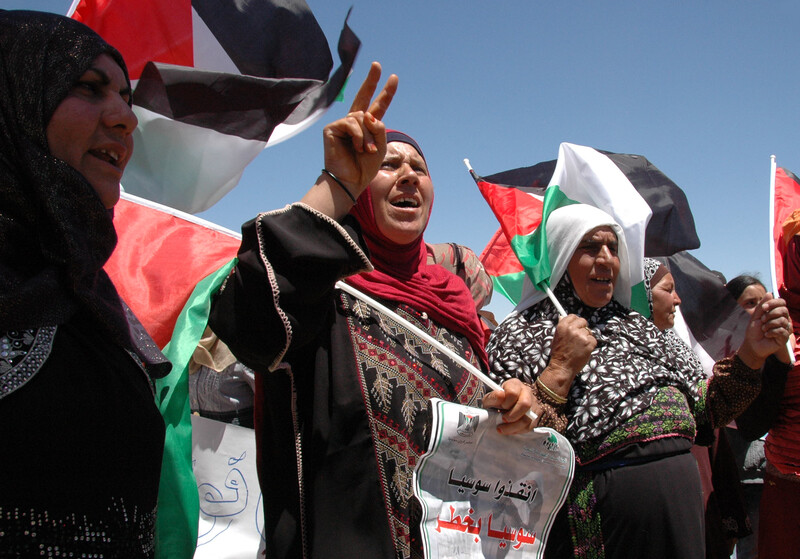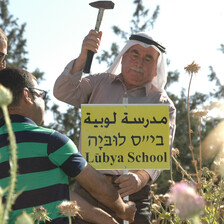The Electronic Intifada 28 May 2015

Palestinians in Susiya demonstrate against Israel’s plans to destroy the village on 16 May.
More than 300 Palestinians in Susiya, a village in the occupied West Bank, face the threat that the Israeli authorities may demolish their homes at any moment.
On 3 August, Israel’s high court is scheduled to consider an appeal made by Susiya’s residents that they be allowed to remain on their land.
Preparing for that date, the residents had sought a judicial order that Israel refrain from destroying their homes before then. Yet on 5 May, Noam Sohlberg, a high court judge, turned down the villagers’ request for an interim injunction. Because of that refusal, the Israeli authorities may demolish around 100 homes whenever they want.
Five days after Sohlberg’s decision, an inspector from the Israeli Civil Administration, a body enforcing the military occupation of the West Bank, arrived in Susiya. Accompanied by soldiers, the inspector took photographs and measurements of the centuries-old Palestinian village, which is located in the South Hebron Hills.
Nasser Nawajeh, one of the 340 people living in Susiya, sees the demolition threat as belonging to a pattern of dispossession.
In 1948, his family was expelled from a village near Arad — today in southern Israel — by Zionist forces. After seeking refuge in Susiya, the family was uprooted from part of the village by the Israeli military in 1986. As a result, they now live on farmland a few kilometers away.
Refugees for a third time?
Nawajeh was taken from Susiya in his father’s arms in 1986. In 1948, his father was similarly carried out of his native village by Nasser’s grandfather.
“My daughter is now nine months old,” Nawajeh said. “I do not want to carry my own children in my arms a third time and for us to be refugees a third time.”
The people of Susiya are particularly vulnerable because they live within Area C. Comprising more than 60 percent of the West Bank, that zone — designated by the Oslo accords — is under full Israeli control.
Israel is seeking to demolish around 100 homes on the pretext that they were not included in a “master plan” for the village. That objection is spurious, considering that — along with 23 other Palestinian villages in the South Hebron Hills — Israel never drew up a “master plan” for Susiya.
In an attempt to ward off the threat of demolition, Susiya’s Palestinian residents drafted such a document in December 2012, assisted by lawyers representing the group Rabbis for Human Rights.
That plan was rejected the following May by the Israeli Civil Administration on what Rabbis for Human Rights described as “questionable grounds.” The villagers have appealed against that rejection. A hearing for that appeal has been set for 3 August by Israel’s high court.
As well as rejecting the villagers’ “master plan,” the Israeli authorities have ordered the demolition of all Palestinian structures in Susiya and that its residents be moved to Yatta. The latter village is located in Area A of the West Bank, which is nominally under the Palestinian Authority’s control.
Goal of expulsion

School principal Muhammad Jaber al-Nawajeh
“This is not a legal issue; it’s a political issue,” said Nawajeh. “The singular goal here is for Israel to expel Palestinians from Area C so that it can annex the land.”
Many of the expulsions affecting Susiya’s Palestinians have been undertaken to accommodate a Jewish-only settlement, which was established in the area during the 1980s. The settlement is also known as Susiya.
Citing “security” considerations, Israel has denied Palestinians in Susiya access to their own wells. Because of the frequent demolitions to buildings in the past, the villagers are now living in tents and shacks.
This is in stark contrast to the treatment of Israeli settlers. All of Israel’s settlements in the West Bank are illegal under international law. Some “outposts” of settlements in the South Hebron Hills also lack approval from Israel.
Despite that status, those “outposts” have nonetheless been supplied with water and electricity — unlike the Palestinians of Susiya.
“You can see the big difference between the settlers who came from all over the world who have the ‘right’ to take our land, and to build modern houses and schools and who are equipped with electricity, heat and swimming pools, while here in Palestinian Susiya, on our own land we are living in tents. And, according to Israel, even our tents are illegal,” Muhammad Jaber al-Nawajeh, the principal of Susiya’s basic school, told The Electronic Intifada. “Is this democracy that in 2015 we are living in tents and Israeli settlers are living in houses?”
The school is among the buildings threatened with destruction.
Noam Sohlberg, the judge who effectively gave the green light for Susiya’s demolition, is himself an Israeli settler living in the West Bank.
Following his decision, villagers have erected a protest tent. It has attracted frequent visits from local and international activists.
Protests against the threatened demolition will continue, according to Nasser Nawajeh, who said: “We want to show the Israeli authorities that if they plan to evict us, at least it won’t be easy.”
Sarah Levy is an independent journalist living in the West Bank. Twitter: @levysarahm





